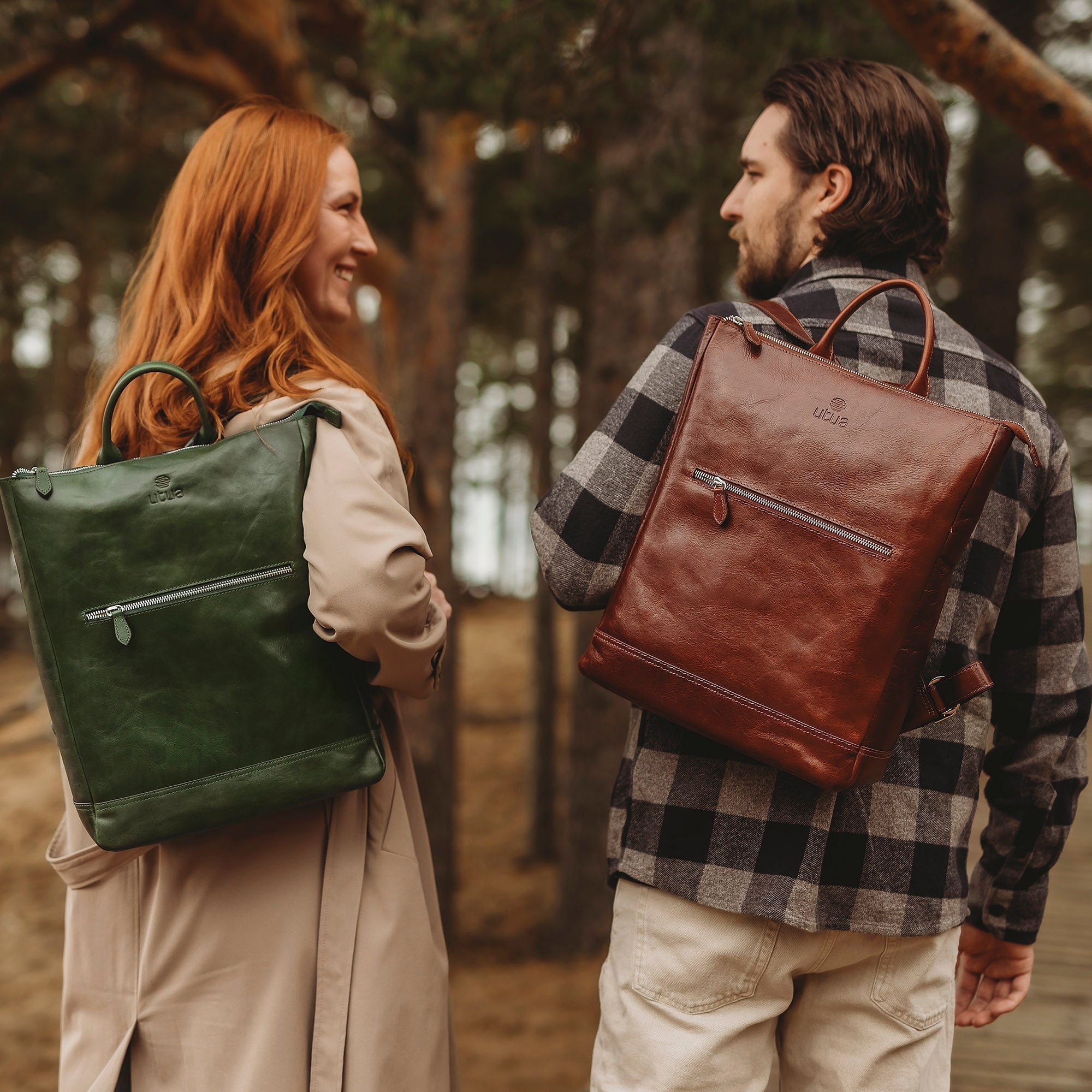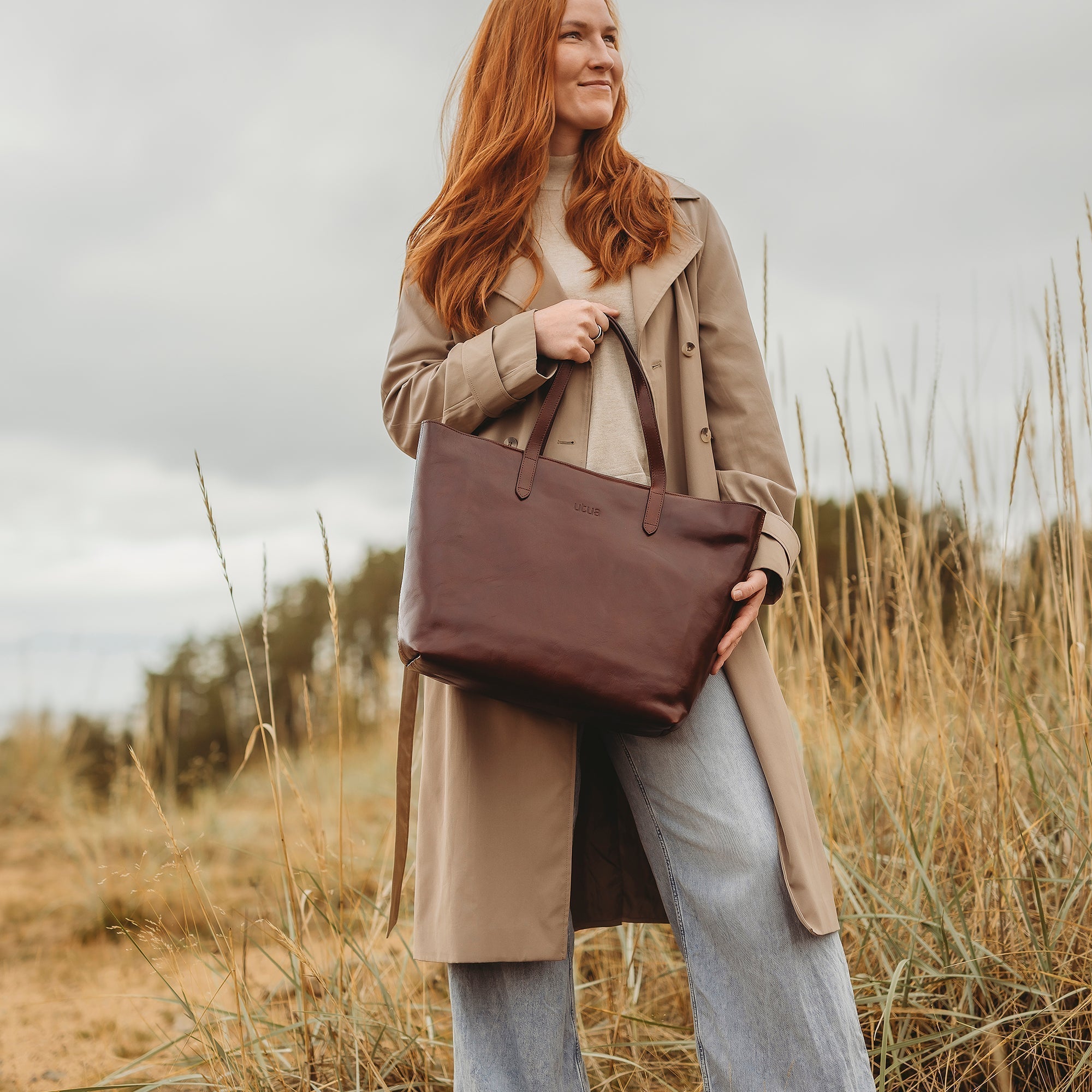Article: Vegetable tanned leather – natural beauty

Vegetable tanned leather – natural beauty
At Utua, we believe in authentic materials and timeless aesthetics, which means vegetable tanned leather. Every vegetable tanned bag tells a story of naturalness, craftsmanship and sustainable beauty. That's why we choose only the best vegetable tanned leather, which is made using traditional methods using nature's own raw materials. It's a responsible choice, but also a question of emotion and quality: a material that only gets better with time.
What is vegetable tanned leather?
Vegetable tanning is a thousands-year-old method of transforming leather into a durable and usable material. It uses natural tannins, usually obtained from the bark, leaves, and seeds of oak, chestnut, mimosa, and other plants.
The vegetable tanning process is slow and manual: raw hides are soaked in tannin-rich solutions for several weeks, during which time the substances contained in the plants bind to the leather's fiber structure, making it durable but also breathable. After the tanning process, each hide is given its own shade and surface by hand dyeing - that's why no two vegetable tanned leathers are exactly the same. Vegetable oils are used for dyeing, which are water-soluble.
This natural method differs from industrial chrome tanning, which in turn gives the leather its own advantages. Vegetable tanning is a chemical-free and environmentally friendly process, which results in a material with a lively surface, long life and character. We want to offer alternatives and therefore we have leather tanned in both ways in our selection.

Lund is a gorgeous, vegetable-tanned bag for work and leisure.
Why choose a vegetable tanned bag?
When you choose a vegetable tanned bag, you choose a material that breathes, develops and patinas beautifully with use. At first, the leather may feel a little stiff, but it quickly softens and molds to its wearer. Vegetable tanned leather may show signs of life, lines and grooves from the start. They also develop over time as the bag is used. Vegetable tanned leather is expressive.
This phenomenon is called patination, and it is the most beautiful feature of vegetable-tanned leather.
Because vegetable tanned leather is made with natural ingredients, it is also safe for both the user and the environment. It does not contain chromium or other heavy metals, and its production does not cause harmful emissions. Vegetable tanning is therefore an ecological choice, but also an aesthetic and high-quality solution.
Utua's love for vegetable-tanned leather
Utua has always valued leather as a material for its authenticity, durability and versatility. For us, vegetable tanned leather is more than an ecological choice – it is part of the value choice we have wanted to offer our customers.
The vegetable-tanned leather we use comes from a factory in the Tuscany region of Italy that adheres to strict environmental standards.
Utua's vegetable-tanned bags are handcrafted, making each bag unique. The leather is hand-dyed, and the dye is rubbed into the leather so that its grain and nuances remain visible. The end result is a bag that exudes natural dignity and whose tone lives in the light and use.
Utua's collection includes several vegetable-tanned bags for different purposes – classic shoulder bags , multi-purpose work bags , compact totes and spacious shoppers . Each one is designed to last, both in style and construction.
Characteristics and care of vegetable tanned leather
Since vegetable tanned leather is a natural material, it is worth investing in its care. If cared for properly, the bag will retain its beauty for decades.
- At first use, the leather may feel stiff, but it softens and bends quickly with regular use.
- Small scratches can be rubbed lightly with your fingertips – skin oil acts as a natural polish.
- Avoid excessive moisture : if your bag gets wet, let it dry at room temperature, not on a radiator or in direct sunlight. After drying, it is a good idea to moisturize the leather with a quality conditioner.
- Avoid leaving your bag in direct sunlight for long periods of time : for example, the heat inside a car can get really high and strong sunlight shining through the window can change the color of the leather.
- Store the bag in a breathable protective bag. You can put crumpled paper inside to help it retain its shape.
- Use a conditioner that helps maintain adequate moisture in the leather; vegetable tanned leather requires more moisture than grain leather.
- You can use a protective spray to provide moisture protection to the leather.
- Maintain regular care routines; for example, twice a year or as needed.
- Also remember the correct use of the bag and For example, avoid overpacking to prevent the leather from stretching and damaging the metal parts.
In Utua's view, a good bag is a living object – it is allowed to change and tell a story along with its wearer. Patina is not a flaw, but a sign of genuine material!

Two traditional styles: vegetable tanning and the classic Visby saddlebag – a great combination!
The natural difference: vegetable tanned vs. marten leather
Chrome-tanned marten leather is the most common type of leather in the industry, as it is faster to produce and cheaper to produce. Chrome tanning uses chemicals that shorten the tanning process and give the leather properties it does not have in its natural state, such as better moisture resistance.
Vegetable tanning, on the other hand, requires time and patience – the entire process can take up to eight weeks. It’s this slowness that makes it so special. Vegetable tanned leather breathes, reacts to light and moisture naturally, and ages gracefully. These are also qualities that are good to consider when choosing a bag. Marooned leather often stays almost the same year after year and is also more resistant to moisture and sunlight, while vegetable tanned leather changes, lives and reacts. It doesn't hide the traces of life - it celebrates them.
That's why Utua believes that a vegetable-tanned bag is the perfect choice for someone who appreciates natural materials and wants to own something real, not artificial.
A responsible choice that lasts for generations
Vegetable tanned leather is also an ethical and ecological choice. Raw hides are a by-product of the food industry and no animals are raised for the bag. Tanning takes place in the EU under strict environmental regulations, and the vegetable tannins used are biodegradable.
When leather is made to last and a product is designed to last, there is less waste and less need to consume. That is the essence of Utua's sustainability philosophy: less, but better.
Utua's vegetable-tanned bags are an investment in both aesthetic pleasure and ecological thinking. When you buy one well-made bag that will last year after year, you save nature and reduce overconsumption.
Utua vegetable-tanned bags – traces of life at its most beautiful
Vegetable tanned leather does not strive for perfection, but is at its most beautiful when it is imperfect. The subtle differences in tone, vibrant surface and natural scent make it a material that tells a story of time and people.
At Utua, this philosophy is reflected in everything we do. A bag is not just a functional item – it is a companion in everyday life, at parties and on trips. Each vegetable-tanned bag is made to last for years and patina beautifully in the hands of its wearer.
If you're looking for a bag made from genuine vegetable-tanned leather that feels good, looks great and ages gracefully, you'll find it at Utua. We believe that responsible design is at its most beautiful when it's made to last.
Utua believes that true quality is found in nature – and that's why every vegetable-tanned bag is made from genuine, living vegetable-tanned leather that lasts time, use and life.


